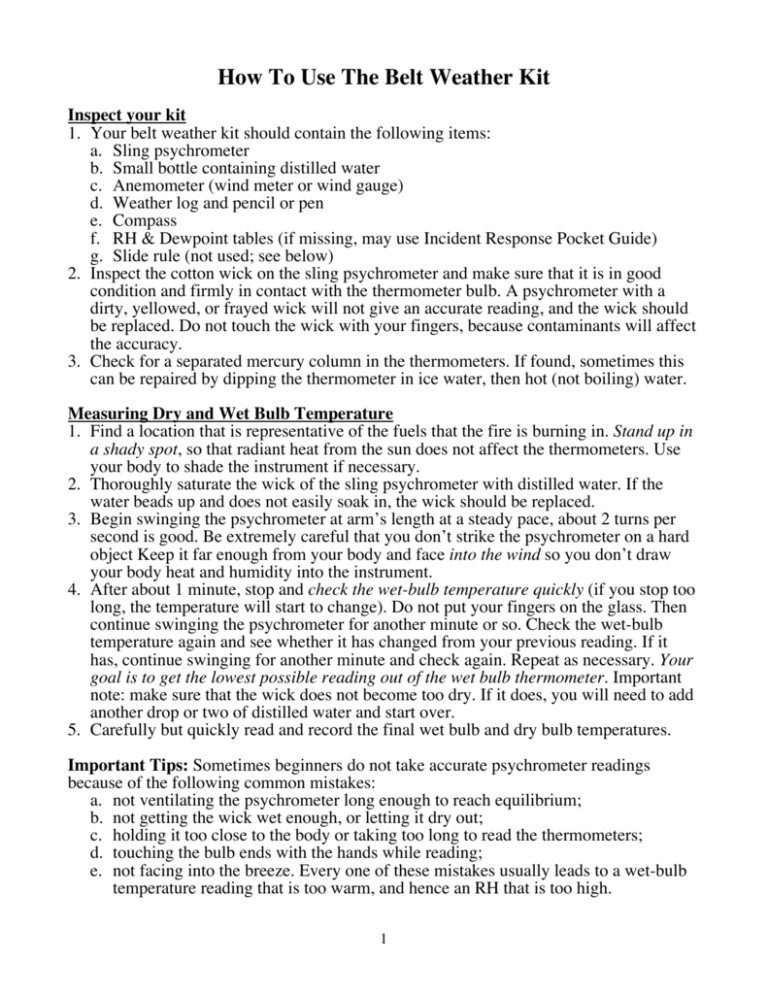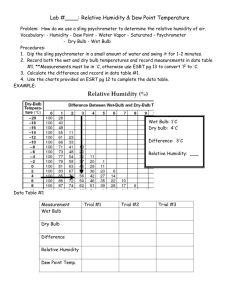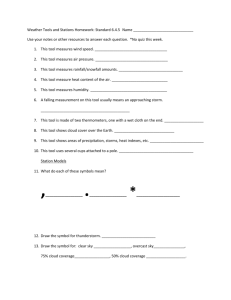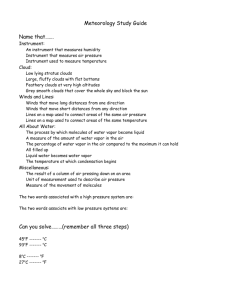How To Use The Belt Weather Kit
advertisement

How To Use The Belt Weather Kit Inspect your kit 1. Your belt weather kit should contain the following items: a. Sling psychrometer b. Small bottle containing distilled water c. Anemometer (wind meter or wind gauge) d. Weather log and pencil or pen e. Compass f. RH & Dewpoint tables (if missing, may use Incident Response Pocket Guide) g. Slide rule (not used; see below) 2. Inspect the cotton wick on the sling psychrometer and make sure that it is in good condition and firmly in contact with the thermometer bulb. A psychrometer with a dirty, yellowed, or frayed wick will not give an accurate reading, and the wick should be replaced. Do not touch the wick with your fingers, because contaminants will affect the accuracy. 3. Check for a separated mercury column in the thermometers. If found, sometimes this can be repaired by dipping the thermometer in ice water, then hot (not boiling) water. Measuring Dry and Wet Bulb Temperature 1. Find a location that is representative of the fuels that the fire is burning in. Stand up in a shady spot, so that radiant heat from the sun does not affect the thermometers. Use your body to shade the instrument if necessary. 2. Thoroughly saturate the wick of the sling psychrometer with distilled water. If the water beads up and does not easily soak in, the wick should be replaced. 3. Begin swinging the psychrometer at arm’s length at a steady pace, about 2 turns per second is good. Be extremely careful that you don’t strike the psychrometer on a hard object Keep it far enough from your body and face into the wind so you don’t draw your body heat and humidity into the instrument. 4. After about 1 minute, stop and check the wet-bulb temperature quickly (if you stop too long, the temperature will start to change). Do not put your fingers on the glass. Then continue swinging the psychrometer for another minute or so. Check the wet-bulb temperature again and see whether it has changed from your previous reading. If it has, continue swinging for another minute and check again. Repeat as necessary. Your goal is to get the lowest possible reading out of the wet bulb thermometer. Important note: make sure that the wick does not become too dry. If it does, you will need to add another drop or two of distilled water and start over. 5. Carefully but quickly read and record the final wet bulb and dry bulb temperatures. Important Tips: Sometimes beginners do not take accurate psychrometer readings because of the following common mistakes: a. not ventilating the psychrometer long enough to reach equilibrium; b. not getting the wick wet enough, or letting it dry out; c. holding it too close to the body or taking too long to read the thermometers; d. touching the bulb ends with the hands while reading; e. not facing into the breeze. Every one of these mistakes usually leads to a wet-bulb temperature reading that is too warm, and hence an RH that is too high. 1 Compute the RH There are various methods to compute the RH from the dry and wet bulb readings: 1. Slide rule calculator – This is not normally used on the fireline because the table is only accurate at sea level. 2. Handheld computer – This is the quick and easy way, but for now we’ll cover the old fashioned way using tables. 3. Pocket weather instrument (such as Kestrel) – This is also a fast way to get the RH, as well as dry bulb temperature. We will discuss these later. 4. RH Tables – These are charts of numbers where you can look up the dry and wet bulb temperatures, and find the corresponding RH (and sometimes dewpoint). These tables should come with your belt weather kit. If you can’t find them, you can use the slightly less accurate tables in the Incident Response Pocket Guide. a. Before you look up the RH, you must verify that you are using the proper chart for your elevation. Each chart has the elevation range printed at the top. Note: the elevation ranges and dry bulb temperature increments are broader in the Incident Response Pocket Guide, and thus those tables are a bit less accurate. b. Find the RH using the tables. i. To use the tables that come with your belt weather kit, find the row with your dry bulb reading along the left side, then follow that row to the right until it matches the wet bulb reading printed above. You will find two numbers here: the dewpoint on top, and the RH on bottom (to remember which is which, the terms are in alphabetical order from top to bottom). ii. To use the tables in the Incident Response Pocket Guide, you first need to calculate the “wet bulb depression”, which is simply the wet bulb minus the dry bulb. Next, find the row with your dry bulb reading along the left side, then follow that row to the right until it matches the wet bulb depression printed above. The table on the left is from the Incident Response Pocket Guide, for elevation range 5000 – 9200. the table on the right is from an RH & Dewpoint table found with a belt weather kit, for elevation range 6101 – 8500. If our dry bulb = 86 and the wet bulb = 55, the first table gives us an RH = 13% (wet bulb depression is 86 – 55 = 31). The second table gives us an RH of 14% and dew point of 31. 2 Complete & Record Your Measurements You have now measured the dry bulb temperature, wet bulb temperature, and Relative Humidity. These all need to be recorded, along with the time of day, in the Weather Log. In addition, you need to measure wind speed, direction, and observe the clouds: 1. To accurately determine wind direction at a glance, tie a two foot length of flagging to a bush or shrub in an unsheltered area. Make a note of the predominate wind direction. You can mark “variable” or “still” if there is little or no wind to measure. 2. Measure wind speed using the Anemometer. a. Hold the instrument out at arm’s length, into the wind. Grasp it at the top, being careful not to block the hole located at the bottom of the back side. This hole is where the wind blows into the instrument, causing the tiny ball to rise. Read the wind speed by looking at the numbers on the left side. b. In the event that the wind speed is greater than 10 mph, you need to use the scale on the right side. To do this, put your finger over the hole on the top of the instrument; you should see the ball quickly drop as the alternate scale is used. Do not be tempted to blow into the hole; this will introduce moist air into the instrument and cause the ball to “stick”. c. Make a note of the average wind speed, and the maximum gusts. This may be recorded like this “5/10” (meaning 5 mph average, 10 mph gusts). 3. Lastly, look around you at the sky. What type of clouds do you see? What part of the sky are they in (N, E, S, W)? How much of the sky is covered by clouds? Do you see any storm cells or lightning? Record these observations in a concise manner. For example: “25% cumulus in SW”. An example of your completed weather observations recorded in the Weather Log. This information is invaluable to the local Fire Behavior Analyst and Meterologist, who may refine future predictions based on your actual observations. Broadcasting the Weather On the fireline, you definitely don’t want to keep your weather observations all to yourself! You both want to monitor the trends on a regular basis, and disseminate that information to other personnel. As a general rule, you should “take the weather” and broadcast a concise weather report at least every 60 minutes on the fireline. During changing weather conditions, increase this to every 30 minutes or more. Be sure to include trends in your report. The following is a good example of a radio report: 3 “All units on the Big Hill Fire stand by for weather” [wait for folks to get their pens and paper ready…] “At 1200, temperature was 85 degrees, up 4 degrees over the last hour. RH is 18%, down from 21%. Winds are 5 to 10 mph from the Northwest. Anyone need a repeat?” The Accuracy Debate Using modern pocket-sized weather instruments such as a Kestrel, you can measure temperature, windspeed, and RH in a matter of seconds. Much has been said about the accuracy of such instruments vs. the sling psychrometer. Here are some facts: 1. The dry bulb temperature and wind speed measurements produced by the Kestrel weather instruments are extremely accurate and can be relied upon. Only the RH is subject to debate. 2. Older generations of the Kestrel instruments were not as accurate as today’s models. The Kestrel 3000, 3500, and 4000 measure RH to within 3%, over the range of 5% to 95%. 3. The Kestrel RH accuracy may drift up to 2% over a two year period. There is a field calibration kit that you may purchase to improve the accuracy to factory specs. 4. There are many factors influencing the accuracy of a sling psychrometer. Common usage errors were already discussed. In addition, thermometers are only so accurate. With only a 1 degree error in the wet bulb reading, and a 1 degree error in the opposite direction on the dry bulb, the resulting RH may be off by as much as 15%! 5. Above all, trends are important when observing weather on the fireline. If you use the same instrument, and use it the same way, your measurements should at least be consistent. If you see the RH dropping steadily, it’s an important warning sign! A PDA-Based Solution For the ultimate tool to assist you in your weather measurements, the Wildland Fire Toolkit software by Pocket Mobility Inc. runs on a small handheld computer, just the right size to tuck into your radio harness or pocket. You can give it the dry and wet bulb readings from your sling psychrometer and the RH will be accurately computed, or you can directly give it the RH from your Kestrel. Either way, all your reading and measurements will be recorded and you can even plot the temperature and RH trends on a graph. In addition, with a few more taps you can compute fine dead fuel moisture, probability of ignition, flamelength, rate of spread, and more in seconds. More info can be found at www.pocketmobility.com. Taking The Next Step Now that you have the basic weather conditions, you can go to the next step and make some quick fire behavior predictions, such as flamelength, rate of spread, probability of ignition, fuel moisture, etc. Using charts found in Appendix B of the Fireline Handbook, you can add observations of fuels and topography to your weather observations to make these estimates. These procedures will be covered in another document. This document was created by Pocket Mobility Inc. and may be downloaded and reproduced at www.pocketmobility.com 4






